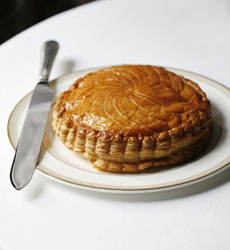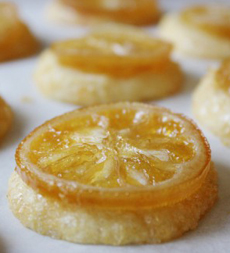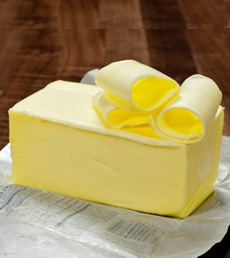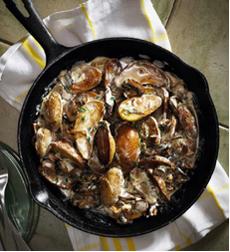|

[1] Crown your “king cake”; the person who finds the charm gets to wear the crown (photo © BainFrance.Blogspot).

[2] An elegant version from Parisian baker and confectioner Pierre Hermé (photos #2 and #3 © Pierre Hermé).

[3] Beautifully designed tops.
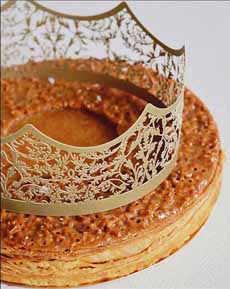
[4] Gâteau des Rois from another great Parisian bakery (and the temple of macarons), Ladurée (photo © Ladurée).

[5] Souvenir du Sud, by Chef Anthony Terrone at the Peninsula Paris. It is in the shape of a calisson, a traditional Provençal candy (photo © Air France).
|
|
Bûches de Noël, fruitcake and Christmas cookies are enjoyed throughout the holiday season. In France, the celebratory confections continue into January with an Epiphany Cake, or Galette des Rois, French for kings’ cake (a galette is a flat cake of pastry).
You can order a Galette des Rois from a French bakery. Alternatively, a recipe to bake your own is below.
But first, some background.
In January, the windows of French pastry shops showcase Galettes des Rois to celebrate the Feast of the Epiphany‡, or Fête de l’Épiphanie in French (January 6th).* The cake is enjoyed beginning a few days before Epiphany, and continuing for a few days after. Some families get a new cake every day!
January 6th is also known as the Twelfth Night, the last night of the 12 days of Christmas. To celebrate, Galettes des Rois are baked throughout France.
Epiphany Cake/Galette des Rois is traditionally a puff pastry (pâte à choux) cake filled with frangipane (almond cream). Other fillings can be substituted, including almond paste, apple, caramel, chestnut, chocolate ganache, and pistachio.
In Provence, in the south of France, the cake, with the medieval-era name of Gâteau des Rois, is an orange-blossom-flavored brioche crown. This style can also be found in Spain and other Spanish-speaking countries.
Other versions of the Galette des Rois are made in Belgium, Germany, Portugal, and Switzerland.
ESSENTIAL: THE FÈVE
But one thing can’t be substituted: the fève. Originally a bean, hidden inside the cake, in modern times it has transformed into a more festive charm (initially a baby, representing baby Jesus) or another trinket that is hidden inside.
The trinket can be anything from a miniature car to a cartoon character (Hello Kitty? Sponge Bob Square Pants?). When we made this cake for a group of adults, we used a key chain featuring a miniature bottle of Champagne.
The French residents of New Orleans made Epiphany Cake part of the Mardi Gras celebration, and it became known as King Cake, but it’s a different style than the French Galette des Rois. Here’s more about it.
Galette des Rois is believed to have originated sometime in the 13th or 14th century, and was initially known as Gâteau des Rois.
A gâteau is a raised cake, frequently iced, while a galette is generally flat, crusty and often filled. The style, the terminology, or both may have changed over time.
While the cake may have originated during the Middle Ages, the tradition of the fève actually has roots stretching back to the Roman Empire. During this time, the Romans celebrated the holiday of Saturnalia, a festival in honor of the pagan god Saturn, the Roman god of agriculture.
According to the Roman writer Justinius, “it has been ordered that at the Saturnalia slaves should everywhere sit down with their masters at the entertainments, the rank of all being made equal” [https://en.wikipedia.org/wiki/Saturnalia].
A “king” for the day was decided via a cake with a hidden bean baked into it.
This tradition has traveled up through the ages. For example, 14th-century Besançon monks of Eastern France would hide a gold coin in a loaf of bread and elect the chief of their chapter based on who got the gold coin.
During this period, the royal court of France had a custom that whoever got the bean in the cake would have to provide drinks for the entire assembly [source].
GETTING THE SLICE WITH THE CHARM
The person who gets the slice with the charm becomes “king” or “queen” for the day and gets to wear the gold paper crown (provided by the bakery or your nearest party store, if you bake your own cake). But it’s an entailed honor:
By tradition, the king has to provide next year’s galette. You can forgo that French tradition in favor of making the Epiphany Cake your annual party treat.
Hiding some type of token in food is a pre-Christian tradition, with roots in the Roman feast of Saturnalia.† A dry bean would be hidden in a dish prepared for the household staff. The slave who got the slice with the bean would be awarded the “kingship” of the day, which included drinking, gambling, and “general bawdiness.”
In fact, in France, the charm/trinket is known as la fève, the French word for bean. Americans have adopted the idea as the Mardi Gras king cake (Mardi Gras, or Fat Tuesday, is celebrated from right after Epiphany until Fat Tuesday, the day before Ash Wednesday).
French chef Héléne Darroze, who commutes each week between the kitchens of the Connaught Hotel in London and her own two-Michelin-starred restaurant in Paris, recalls celebrating the Epiphany feast as a child.
Growing up in southwestern France, “each year there would be a series of family parties, and the person who found the token in the cake would buy the charms for the following day’s galette.”
|





